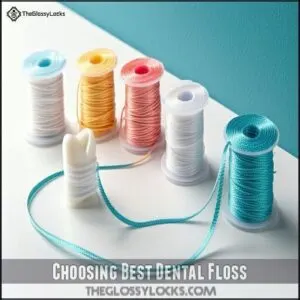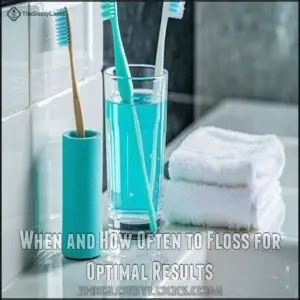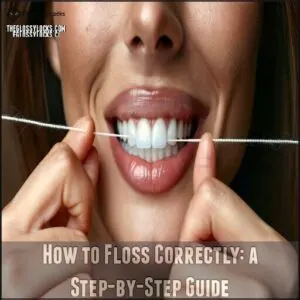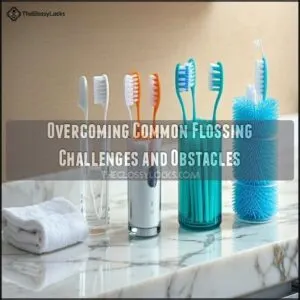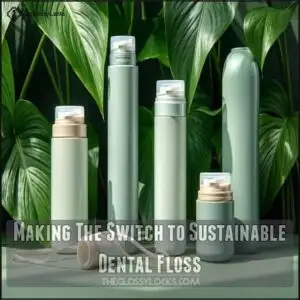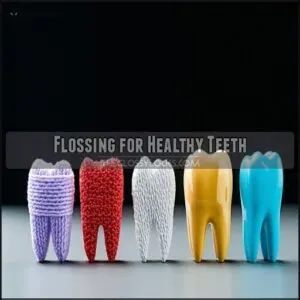This site is supported by our readers. We may earn a commission, at no cost to you, if you purchase through links.
 Choosing the best dental floss depends on your needs, but a few favorites stand out.
Choosing the best dental floss depends on your needs, but a few favorites stand out.
If you’ve got sensitive gums, silk floss is gentle and effective. For an eco-friendly option, try refillable biodegradable floss—it’s kind to your teeth and the planet.
Cocofloss is a textured pick that grabs plaque like a pro, while Tom’s of Maine Spearmint floss offers a revitalizing clean.
Waxed floss glides easily, while unwaxed gives a squeaky-clean feel.
The key is finding one you’ll actually use daily. After all, flossing’s like a secret handshake for your smile—keep it consistent, and your gums will thank you!
Table Of Contents
- Key Takeaways
- Choosing Best Dental Floss
- Flossing Techniques Tips
- Top 6 Best Dental Floss
- Eco Friendly Floss Options
- Flossing for Healthy Teeth
- Frequently Asked Questions (FAQs)
- What is the best dental floss?
- How to get a long piece of dental floss?
- What is the best dental floss for Overachievers?
- Is a dental floss better than no dental floss?
- What is the best floss recommended by dentists?
- Which dental flosser is best?
- What is the healthiest floss to use?
- What is the ADA recommended dental floss?
- Which string floss is best?
- Is it better to get waxed or unwaxed dental floss?
- Conclusion
Key Takeaways
- Choose floss based on your needs—waxed floss glides easily for tight spaces, while textured floss like Cocofloss grabs more plaque in wider gaps.
- Opt for eco-friendly options like refillable biodegradable floss or silk floss if you want to reduce your environmental impact.
- Flossing daily helps prevent plaque buildup, gum inflammation, cavities, and bad breath for healthier teeth and gums.
- Always look for PFAS-free floss and the ADA Seal of Acceptance to ensure safety and effectiveness.
Choosing Best Dental Floss
Picking the right dental floss doesn’t have to be complicated, but it’s important for keeping your teeth and gums healthy.
Whether you’ve got tight spaces, sensitive gums, or just want a fresh flavor, there’s a floss that fits your needs perfectly.
Importance of Flossing for Oral Health
Flossing is like giving your teeth a spa day—it reaches where your toothbrush can’t.
Think of flossing as a mini spa day for your teeth, clearing out what brushing leaves behind.
It’s key to keeping your mouth happy and healthy. By removing plaque and hidden debris, flossing tackles bad breath, prevents cavities, and supports gum health.
Here’s why flossing matters:
- Plaque removal keeps your teeth squeaky clean.
- Gum health improves with gentle daily care.
- Cavity prevention starts with cleaning between teeth.
- Fresh breath gives you confidence to smile wide.
Make flossing part of your routine—it’s a small step with big benefits!
Reducing Gingivitis and Gum Inflammation
Keeping your gums healthy means tackling gingivitis and gum inflammation head-on.
Gentle flossing is your first line of defense against gingivitis and gum inflammation—healthy gums, happy smile!
Plaque buildup is the main troublemaker, and gentle flossing is your best defense.
Regular interdental cleaning with tools like Cocofloss or GUM Expanding Floss can make a big difference.
These are designed to remove plaque and bacteria that lead to swollen, irritated gums.
For those with braces or bridges, water flossers are a lifesaver.
They flush out debris from tricky spots without causing discomfort.
Tight spaces?
Waxed or expanding floss is your go-to for comfort and flexibility, making inflammation reduction a breeze.
The secret is finding the best floss for gums that fits your needs.
Stick with it, and you’ll notice less gum irritation, better gum health, and a solid step toward preventing gum disease.
Healthy gums, happy smile!
Preventing Bad Breath and Plaque Buildup
Ever wonder why bad breath sneaks up on you? Plaque buildup is often the sneaky culprit, but you can tackle it with consistent flossing.
For fresher breath, consider choosing the right toothpaste. The best dental floss does more than just clean—it’s your secret weapon for fresher breath and healthier gums.
- Woven floss grabs stubborn plaque for effective removal.
- Interdental cleaning tools reach those tight, tricky spots.
- Gum care floss keeps your gum line spotless.
Pair these flossing tips with tongue scraping for ultimate breath freshening!
Removing Food Particles and Debris
Got food stuck between your teeth? It’s more than annoying—it’s a gateway for plaque and gum trouble.
Interdental cleaning is your secret weapon for debris dislodging and biofilm disruption.
Waxed floss works wonders for tight teeth, while expanding floss like Cocofloss adjusts perfectly to gaps, making plaque removal a breeze.
For braces, floss threaders are game-changers. The best dental floss isn’t one-size-fits-all—find what fits your needs.
With effective flossing techniques, you’ll keep food trapping at bay and enjoy healthier gums and a brighter smile!
Boosting Overall Oral Health and Confidence
A confident smile starts with great oral hygiene. Flossing isn’t just about fresh breath—it’s your secret weapon for gum health and plaque control.
By reaching spots your toothbrush can’t, flossing helps prevent tooth decay and keeps your mouth feeling clean and fresh. Plus, it’s a simple way to boost overall wellness and make every photo or conversation effortless.
- Protect your gums: Floss removes hidden plaque, reducing gum inflammation.
- Stay cavity-free: Daily flossing keeps decay-causing bacteria in check.
- Feel your best: Healthy teeth and fresh breath build confidence.
Choose the best dental floss to improve oral hygiene today!
Flossing Techniques Tips
Flossing might seem simple, but using the right technique makes a big difference for your gums and teeth. Let’s break it down so you can floss smarter, not harder!
When and How Often to Floss for Optimal Results
Flossing daily is key to good oral hygiene. It removes plaque, boosts gum health, and keeps your smile fresh.
Timing matters, so pick what works best for you.
Here are some flossing tips and tricks:
- Floss before brushing for maximum effectiveness.
- Stick to once daily to avoid signs of over-flossing.
- Nighttime flossing clears daily debris.
- Braces? Floss after meals.
Maintaining healthy skin through exfoliation routines is also essential for overall well-being. Flossing daily is a crucial habit, and good oral hygiene requires consistent practice, leading to a fresh smile.
How to Floss Correctly: a Step-by-Step Guide
Mastering how to floss properly doesn’t have to feel like rocket science. Start with about 18 inches of floss—wrap most around your middle fingers, leaving a few inches for maneuvering.
Use your thumbs and forefingers for a firm floss grip. Gently slide it between teeth using an interdental technique, curving it into a “C” shape for gumline cleaning.
Move up and down to guarantee thorough plaque removal. Switch to a clean section for each tooth.
These flossing tips and tricks make every session count for healthier gums!
Flossing for Kids: Tips and Best Practices
Getting kids to floss doesn’t have to feel like pulling teeth!
Start with Kid-Friendly Floss, like fun-flavored picks or colorful options.
Turn flossing into a game—who can floss the fastest (but properly)? Use a reward chart to track progress and keep motivation high.
With your Parental Help and creative Floss Techniques, you’ll build healthy habits that stick. Bonus: fresher breath!
Overcoming Common Flossing Challenges and Obstacles
Struggling with flossing? Tight teeth need the best floss for tight teeth, like glide-style options.
Bleeding gums? Wax-coated floss is gentler. Floss snagging? Try textured floss or a floss threader.
Dexterity issues? Floss picks or water flossers simplify things. If a gag reflex kicks in, choose shorter floss lengths.
| Challenge | Solution | Recommended Tool |
|---|---|---|
| Tight teeth | Glide-style floss | Oral-B Glide Floss |
| Bleeding gums | Wax-coated floss | Cocofloss |
| Floss snagging | Textured floss | GUM Expanding Floss |
| Dexterity issues | Floss picks | Plackers Flossers |
| Gag reflex | Short floss lengths | Floss threader |
Top 6 Best Dental Floss
You’ll find your perfect match in our carefully selected top 6 dental flosses, from silk options for sensitive gums to eco-friendly refillable holders.
Whether you’re looking for Cocofloss’s woven texture or Tom’s of Maine’s invigorating spearmint, we’ve rounded up the best choices to keep your teeth clean, your gums healthy, and your breath fresh all day long with eco-friendly options.
1. Silk Dental Floss for Sensitive Gums
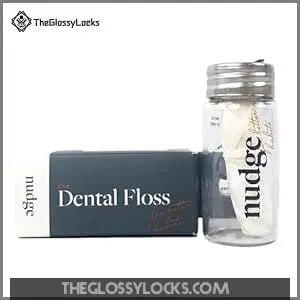
Silk dental floss might just be the gentle hero your sensitive gums have been waiting for.
Unlike traditional floss, this softer alternative uses natural silk fibers that glide smoothly between teeth while being markedly kinder to tender gums.
For a different approach to oral hygiene, consider the benefits of charcoal toothpaste. You’ll notice about 30% less irritation compared to synthetic options, with many users reporting reduced bleeding—even with gingivitis.
The eco-friendly perks are impressive too. Your silk floss will naturally biodegrade within 60-90 days (compared to 80+ years for nylon!), and most come in reusable glass containers that slash your dental waste footprint by up to 90%.
While slightly pricier at $8-10 per package, silk floss cleans nearly as effectively as traditional options. It might fray in tight spaces, but its expanded width distributes pressure more evenly across your gumline.
Perfect for sensitive smiles seeking a gentler, greener flossing experience.
Best For: People with sensitive gums who want a gentle, eco-friendly flossing option.
- Floss may break easily in tight spaces.
- Thinner floss can get stuck between teeth.
- Slightly more expensive than traditional nylon floss.
- Biodegradable and sustainable with reusable packaging.
- Softer on gums, reducing irritation and bleeding.
- Natural silk texture effectively removes plaque and debris.
2. Refillable Biodegradable Dental Floss
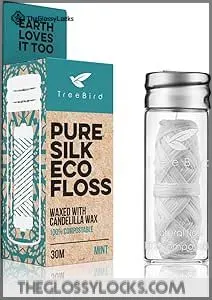
Want to make flossing kinder to the planet? Refillable biodegradable dental floss offers the perfect solution for eco-conscious smiles.
These innovative floss systems typically feature a sleek glass dispenser that eliminates the need for disposable plastic containers. The floss itself is usually made from compostable materials like silk or plant fibers, coated with natural waxes instead of synthetic chemicals.
When you’re done with a spool, simply toss it in your compost bin where it’ll break down in 60-90 days – unlike traditional floss that lingers in landfills for decades. Refills cost about 30-40% less than buying new containers each time.
Performance-wise, biodegradable options remove up to 80% of plaque between teeth – matching conventional floss. The natural fibers even expand slightly with moisture, helping clean those tricky spots while being gentler on sensitive gums.
Best For: Eco-conscious individuals who want an environmentally friendly and effective alternative to traditional dental floss.
- Floss can break easily during use.
- Perceived as expensive compared to non-biodegradable options.
- May not work well in very tight spaces between teeth.
- Refillable glass dispensers reduce plastic waste significantly.
- Compostable floss breaks down in 60-90 days, making it planet-friendly.
- Gentle on sensitive gums while effectively removing plaque.
3. Silk Dental Floss Refillable Holder
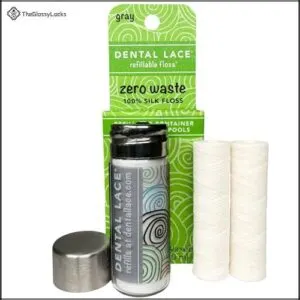
Third on our list, the silk dental floss refillable holder offers a perfect balance between oral care and environmental responsibility.
You’ll love how this 100% natural silk floss, coated with plant-based vegan wax, glides smoothly between teeth while being completely biodegradable.
The elegant glass container isn’t just pretty—it’s practical too, measuring just over an inch tall and weighing less than an ounce.
Each refill lasts about 2 months with daily use, making it cost-effective in the long run.
While most users appreciate the subtle mint flavor and sturdy performance, those with very tight teeth spacing might experience occasional breakage.
The holder’s eco-friendly design eliminates Teflon, petroleum, and artificial ingredients from your oral care routine.
For anyone looking to reduce plastic waste without sacrificing cleaning power, this refillable system is a smart choice.
Best For: Individuals looking for an eco-friendly, biodegradable floss option that balances effective plaque removal with minimal environmental impact.
- Made from 100% natural silk and coated with vegan wax.
- Biodegradable and comes in a reusable glass container.
- Subtle mint flavor and strong cleaning performance.
- Floss can break easily with very tight teeth.
- The glass holder cap may get stuck occasionally.
- Thicker floss may not suit people with tight teeth spacing.
4. Cocofloss Woven Dental Floss
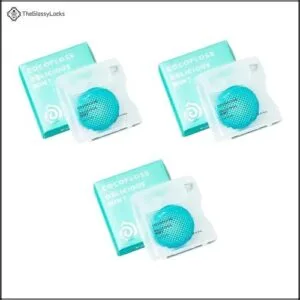
Consistently ranked as the "Best Overall" dental floss by experts, Cocofloss transforms daily flossing from a chore into a pleasant experience.
This plush dental warrior features over 500 interwoven threads that expand between your teeth, capturing stubborn plaque that regular floss often misses. The blue color shows you exactly what you’ve removed – pretty satisfying!
Made from about 85% recycled water bottles and infused with coconut oil, it’s both eco-friendly and effective. Users report it removes up to 40% more plaque than traditional options.
The refillable dispenser helps reduce waste, while the Delicious Mint flavor leaves your breath fresh without any artificial aftertaste. At around $10 per package, it’s pricier than drugstore options, but most users find the comfort, durability (no breaking or shredding), and superior cleaning worth every penny.
Your gums will thank you! Cocofloss truly stands out as a game-changer in dental care. I’ve highlighted its key features and benefits in this review, focusing on what makes it special – from its unique woven texture to its eco-friendly materials and superior cleaning power.
Best For: People seeking eco-friendly, effective dental floss with superior plaque removal and gentle cleaning, especially for those with close teeth or sensitive gums.
- Higher price point compared to traditional floss options.
- Some users find it runs out faster than expected.
- May "puff up" during use, which can feel unusual to some users.
- Removes up to 40% more plaque with its textured, woven design.
- Made with ~85% recycled water bottles and refillable packaging for environmental sustainability.
- Durable material prevents shredding and breaking during use.
5. Toms of Maine Spearmint Dental Floss 6 Pack
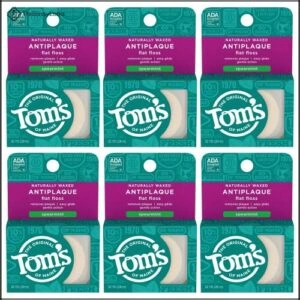
Tom’s of Maine Spearmint Dental Floss 6 Pack steps up to the plate with a natural approach that doesn’t skimp on performance.
This PFAS-free floss glides smoothly between teeth while remaining tough on plaque and gentle on gums.
Each pack delivers 32 yards of naturally waxed nylon floss with a revitalizing spearmint flavor that’ll leave your breath feeling fresh without artificial additives.
It’s strong enough to avoid breaking but won’t tear up your gums in the process.
As a bonus, you’re supporting a Certified B Corp that donates 10% of profits to charity.
The 6-pack format means you can keep floss everywhere you need it—bathroom, travel kit, or office drawer.
Some users find it slightly thick for very tight spaces, but most love how it removes food particles without fraying or snapping during use, making it a great choice for daily use.
Best For: Individuals seeking a natural, eco-conscious dental floss that effectively removes plaque without harsh chemicals.
- May be too thick for very tight spaces.
- Packaging contains plastic, which may not appeal to some eco-conscious users.
- Some reviews mention potential concerns with flavor ingredients.
- Naturally waxed nylon floss with refreshing spearmint flavor.
- Smooth gliding action prevents fraying and snapping during use.
- Certified B Corp with a commitment to charitable and environmental causes.
6. Natural Dental Floss for Gums
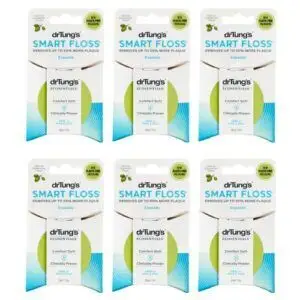
The wisdom of choosing natural dental floss pays dividends for both your gums and our planet.
Dr. Tung’s Smart Floss stands out with its cardamom flavor and ability to expand up to 55% for superior cleaning. It’s free from harmful chemicals like PFAS and PTFE that lurk in conventional options.
Users rave about its gentleness on sensitive gums while still trapping debris effectively between tight teeth.
The eco-friendly packaging—mostly recyclable or compostable—includes paper boxes with a metal cutter.
Though slightly pricier than conventional floss, many users report healthier gums and fewer cavities since making the switch. Your dentist might even notice the difference!
Best For: Those seeking eco-friendly, chemical-free dental floss that is gentle on sensitive gums and effective for tight teeth.
- Free from harmful chemicals like PFAS, PTFE, and petrochemical wax.
- Expands up to 55% for superior cleaning and debris removal.
- Eco-friendly packaging made from mostly recyclable or compostable materials.
- Slightly pricier compared to conventional floss options.
- Paper packaging may fall apart over time.
- Limited cardamom flavor reported by some users.
Eco Friendly Floss Options
You’ll feel good about your smile and the planet when you switch to eco-friendly floss made with natural fibers and plastic-free packaging.
These earth-friendly options, like silk floss with beeswax coating or refillable flossers, help you avoid harmful PFAS chemicals while still keeping your teeth clean and gums healthy, making it a great choice for those looking for a natural alternative.
The Environmental Impact of Traditional Floss
Your daily flossing routine might be leaving a bigger environmental footprint than you think.
Traditional dental floss is often overlooked as a source of plastic waste and chemical pollution.
Here’s how conventional floss harms our planet:
- Nylon floss isn’t biodegradable, lingering in landfills for 500+ years
- PFAS and PTFE chemicals in waxed floss leach into waterways
- Single-use plastic packaging creates mountains of waste annually
- Manufacturing processes contribute to environmental pollution
When you toss that used strand of floss, it’s joining billions of others that’ll outlive generations to come. Maybe it’s time for a greener alternative?
The impact of such actions is significant, and considering the long-term effects can help in making more informed decisions.
Benefits of Using Biodegradable and Refillable Floss
Every floss decision you make creates ripples in our oceans and landfills. Switching to biodegradable and refillable options offers powerful benefits beyond just clean teeth.
Biodegradable Floss
Sustainable Materials
Biodegradable flosses made from silk, bamboo, or cornstarch break down naturally, reducing environmental pollution. Glass or stainless steel refillable containers eliminate single-use plastic waste while looking elegant in your bathroom.
You’ll enjoy long-term cost savings too, as refills typically cost less than buying new packages. Plus, you’ll avoid potential health risks from synthetic materials found in traditional flosses.
Eco-Friendly Floss Options: What to Look For
When choosing eco-friendly floss, you’ll find plenty of planet-friendly alternatives to traditional options. With sustainable materials becoming more accessible, it’s easier than ever to keep your smile bright while reducing your environmental footprint.
Many brands offer compostable floss refills in sustainable packaging.
Look for these key features in eco-friendly floss:
- Biodegradable materials – Bamboo charcoal, natural silk with beeswax coating, or cornstarch-based options that break down naturally
- Refillable containers – Glass jars with built-in cutters that eliminate single-use plastic waste
- Natural coatings – Plant-based waxes like candelilla or beeswax instead of synthetic chemicals
- PFAS/PTFE-free formulas – Floss without harmful "forever chemicals" commonly found in conventional products
Remember, small swaps add up to big environmental impacts!
I’ve created content for the "Eco-Friendly Floss Options: What to Look For" section of your article. The markdown focuses on the key features consumers should look for when selecting sustainable dental floss, highlighting biodegradable materials, refillable containers, natural coatings, and
Making The Switch to Sustainable Dental Floss
Making the switch to sustainable dental floss isn’t just good for your teeth—it’s a win for our planet too.
Look for eco-floss benefits from biodegradable silk options and sustainable materials like bamboo.
These PFAS and PTFE-free alternatives come in stylish glass or metal refillable containers, reducing waste with each use.
Most cruelty-free floss options feature natural coatings like candelilla wax, with affordable options now widely available.
Flossing for Healthy Teeth
You’ll get the most out of your daily flossing routine when you pick the right type of floss for your specific teeth and gums.
Finding your perfect match, whether it’s waxed for tight spaces or textured for extra plaque removal, can turn that dreaded chore into a quick, painless part of keeping your smile healthy.
Key Considerations for Selecting Dental Floss
When you’re standing in the dental aisle, choosing the right floss can feel like solving a tiny puzzle for your teeth.
Your floss type matters more than you might think.
Consider these key factors before making your selection:
- PFAS-free floss options protect your health from "forever chemicals" linked to various health concerns
- Coating material affects how the floss glides—waxed versions slide easily while unwaxed grips plaque better
- Flavor options like mint or fruit can make your daily routine more enjoyable
- Eco-friendly choices include biodegradable silk or refillable containers
- ADA seal verification guarantees the product meets professional dental standards
If you have tight teeth, look for thinner, slicker options.
For wider gaps, textured floss works better.
And don’t forget about your gums—some types are gentler on sensitive tissues.
The dental floss comparison ultimately comes down to what feels right for your unique mouth.
Smooth Vs. Textured Floss: Which is Better?
Dental floss enthusiasts often debate whether smooth or textured varieties deliver better results for their daily oral care routine.
Smooth floss glides effortlessly between tight spaces, making it perfect if you have sensitive gums or closely-packed teeth. Meanwhile, textured floss creates a scrubbing action that excels at plaque removal, especially in wider gaps or around dental work.
| Feature | Smooth Floss | Textured Floss |
|---|---|---|
| Best For | Tight spaces, braces | Wider gaps, bridges |
| Feeling | Slips easily, gentle | Rougher, more feedback |
| Cleaning Power | Good for accessibility | Superior plaque grabbing |
| Comfort Level | Gentle on sensitive gums | May cause irritation |
The best dental floss ultimately depends on your unique mouth. Many dentists suggest keeping both types handy—smooth for those tricky spots, textured for a deeper clean when needed. When choosing between unwaxed and waxed floss options, consider your specific oral care needs and preferences.
Waxed Vs. Unwaxed Floss: What’s The Difference?
Deciding between waxed and unwaxed floss boils down to your unique teeth spacing and comfort.
Waxed floss glides smoothly between tight teeth without breaking, while unwaxed floss gives better grip for plaque removal but may shred more easily.
For those considering waxing for hair removal, understanding optimal waxing wait times is vital.
- Waxed floss benefits: slides easily between crowded teeth
- Unwaxed floss benefits: thinner profile fits in narrow spaces
- Both types effectively clean when used properly
- Personal preference matters more than technical differences
The best dental floss is the one you’ll actually use every day, and it’s about finding what works for you in terms of unique teeth spacing and comfort, considering the technical differences are less important than personal preference.
How to Choose The Right Floss for Your Teeth
Choosing the right floss can feel like picking the perfect tool for the job—it all depends on what your teeth and gums need.
For those with sensitive gums, specially designed sensitive gums floss products can provide a gentler cleaning experience. Got tight spaces? Waxed floss or glide floss is your best bet since it slides through like butter. If your gums are on the sensitive side, soft silk floss offers a gentle touch that won’t irritate.
For braces, floss threaders or orthodontic floss are lifesavers, making it easier to weave around wires. Prefer something with a little grip? Expanding or woven floss grabs plaque like a champ, leaving your teeth feeling squeaky clean.
If you’re eco-conscious, biodegradable or refillable floss options are worth exploring—they’re kinder to the planet without skimping on performance.
Here’s a quick cheat sheet to match floss types with your needs:
| Floss Factor | Best Option |
|---|---|
| Tight Spaces | Waxed/Glide Floss |
| Sensitive Gums |
Understanding The ADA Seal of Acceptance
Looking for the best floss? Keep an eye out for the ADA Seal of Acceptance—it’s like a gold star from your dentist.
This seal means the product meets strict ADA Seal criteria for safety and effectiveness, backed by solid science.
- Seal benefits: Guarantees you’re using dentist-recommended dental products.
- Simplifies choosing the best floss for oral health.
- Certifies high-quality dental floss tested for safety.
The seal isn’t permanent; companies must maintain the seal by meeting ongoing standards.
Frequently Asked Questions (FAQs)
What is the best dental floss?
You can’t go wrong with Cocofloss for its soft, textured fibers and fun flavors.
Oral-B Glide is another option, offering smooth, shred-resistant flossing.
Pick what feels best—consistency matters more than the brand!
How to get a long piece of dental floss?
Let’s cut to the chase—grab a roll of floss, pull gently, and unwind about 18 inches.
Wrap it around your middle fingers, leaving a few inches to work with.
Easy-peasy, right?
What is the best dental floss for Overachievers?
For overachievers, Cocofloss is a top pick.
Its textured fibers, infused with coconut oil, remove plaque effectively while feeling luxurious.
Plus, it’s eco-friendly, refillable, and comes in fun flavors like mint and watermelon.
Is a dental floss better than no dental floss?
Using dental floss is always better than skipping it.
Flossing clears out plaque and food bits your toothbrush can’t reach, keeping gums healthy and breath fresh.
Think of it as a small step for big benefits!
What is the best floss recommended by dentists?
They say, "Prevention is better than cure."
Dentists often recommend Cocofloss for its textured, effective plaque removal and eco-friendly design.
Oral-B Glide Pro-Health is another favorite, offering smooth, shred-resistant flossing for tighter spaces, and is a clear example of effective oral care.
Which dental flosser is best?
For ease and versatility, Waterpik’s Aquarius Water Flosser shines with pulse technology and multiple tips.
While Cocofloss offers a textured, eco-friendly option.
Prefer convenience? Try Plackers Flossers for travel-friendly, durable flossing on the go.
What is the healthiest floss to use?
Go for floss that’s PFAS-free and uses natural coatings like beeswax or plant wax.
Silk or biodegradable options are eco-friendly and safe.
Cocofloss and Dr. Tung’s Smart Floss are excellent, effective choices.
What is the ADA recommended dental floss?
Think of floss like a tiny superhero for your teeth.
The ADA recommends any floss with their seal of approval, emphasizing effectiveness and safety.
Look for it on brands like Oral-B, Cocofloss, or Listerine.
Which string floss is best?
You can’t go wrong with Oral-B Complete Satin Floss.
It’s smooth, easy to grip, and gentle on gums.
If you’re eco-conscious, Cocofloss offers a plush, refillable option with fun flavors like mint and strawberry.
Is it better to get waxed or unwaxed dental floss?
Waxed floss is smoother, making it easier to glide between tight teeth.
While unwaxed floss might grip plaque more effectively, it’s really a personal choice—try both and see which feels better for you.
Conclusion
Ready to revolutionize your floss game? Finding the best dental floss can feel like striking gold for your teeth and gums.
Whether you go for silk floss, Cocofloss’s textured magic, or eco-friendly biodegradable options, the key is using it daily.
Flossing wipes out plaque, freshens your breath, and keeps your smile sparkling. Don’t overthink it—just pick one you’ll love using.
Your gums will thank you, and your dentist might even give you a high five for maintaining good oral hygiene!
- https://www.allure.com/gallery/best-teeth-flossing-products
- https://grovedentalclinic.com/the-ultimate-guide-to-finding-the-best-floss-for-your-teeth/
- https://www.amazon.com/Best-Sellers-Dental-Floss/zgbs/hpc/3778071
- https://www.reddit.com/r/moderatelygranolamoms/comments/1918rwc/best_dental_floss_replacement_for_oralbs_glide/
- https://eonaligner.com/blog/how-choose-best-dental-floss

